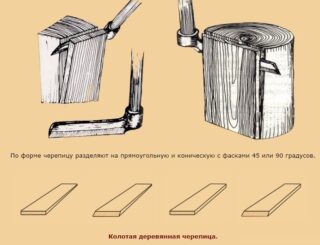Timber shingles are one of the most sustainable and aesthetically pleasing roofing materials. It can be used not only for the roof, but also for cladding the walls of the facade of the house.
Types of wooden tiles
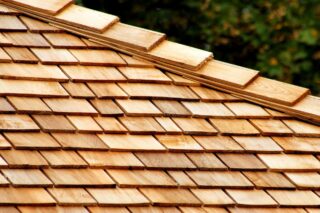
Wood-based roof coverings are of various types. They are distinguished by the exactingness of laying and the appearance of the resulting surface. The following types of roofing can be distinguished:
- Shingles are the easiest material to make, looking like thin and long planks of small width (about 0.1 m). Due to its thinness, this coating is not as durable as other options. The shortened shingle (no more than 0.5 m long) is called chips. They are laid according to the same principle on the prepared crate, while the upper products should overlap the butt joints of the lower ones. The step of the lathing for chips is less than for shingles. The overlap is necessary so that the sediments flowing down the slope do not penetrate under the roof, creating an environment that attracts mold and fungal colonies.
- Shingle - a tile made of wood with a wedge-shaped cut. Its elements are provided with slots designed to accommodate a wedge of an adjacent board. Products are chipped and sawn.
- Shindel - the so-called boards that are chipped from the deck without violating the integrity of the fibers. Compared to shingles, they have a slightly greater thickness and a lower percentage of moisture. Lay it in a similar way. In quality products, the annual rings are located at an angle of 30 degrees.
- Plowshares are hand-made products with carved edges and excellent decorative qualities. They are often used to decorate barrels and poppies. In private construction, they are rarely used due to the high price.
- Tes - long (up to 6 m) boards obtained as a result of sawing a log lengthwise. Their thickness is 2-3 cm, width is 10-15. Due to the large dimensions of the elements, the arrangement of the roof is easy and quick. They are mounted on a standard crate.
Tes is the cheapest of wood roofing materials. The breed used also affects the price category.
Material selection
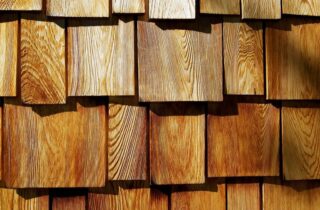
On sale there are tiles made of larch, oak, pine, aspen and other species. Conifers are more moisture resistant due to their high resin content, but some deciduous ones are more durable.
Larch shingles work well for roofing, as they are more resistant to decay than other options. However, this does not eliminate the need for antiseptic treatment. Another attractive property of larch is its strength, comparable to that of oak.
Do-it-yourself shingles can also be made from pine. Such products can last 30-60 years.
Benefits of wood roofing
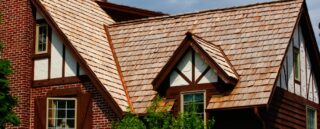
One of the main parameters taken into account when choosing materials for construction is their weight. It determines the load on the foundation. For example, if the walls and floors of several rooms are planned to be tiled, it is better to choose a monolithic concrete base, since the tile creates a large load. For tiles made of wood, this indicator is average. It doesn't make the building very heavy.
Other advantages of the material include environmental friendliness, affordability, good thermal insulation qualities.It is easy to install and do it yourself (it is only important to determine the size of the products).
High-quality shingles can serve for more than half a century. However, due to its susceptibility to moisture and flammability, it must be periodically treated with fire retardant and antiseptic impregnations.
A wooden roof is not suitable for all roofs, but only with a slope of at least 45 degrees. This is due to the wood's susceptibility to moisture. The design must ensure timely drainage of excess water.
Material production
It is better to produce material with a margin of 10-20% of the required amount, since a certain percentage of products are often damaged during the installation process.
It is recommended to harvest wood in late spring and summer. In the cold season, this should not be done. Aspen of April harvesting over time acquires a beautiful silvery hue. The core of the logs should not be used for the manufacture of shingles due to its softness.
Making your own shingles can cut costs in half, but the process takes time. Since it can be sawn and chipped, it is necessary to purchase the appropriate tool. Raw materials are pre-dried to 18-20% for several months or even years. Too dry material tends to crack, and wet material rots easily.
You should choose those parts of the trees where there are the fewest knots. Young parts are not suitable due to the increased tendency to decay. The best option is to use segments from the root to the first knot. They are resinous, even and have little moisture. Previously, the bark is removed from them, otherwise the material will not last long. From such logs, blanks are created, and from them, in turn, dies of small thickness (up to 1 cm). They are coated with compounds that protect against decay and fire. They can then be sanded and smoothed. For the manufacture of shingles, you can purchase a wide cleaver or work on a special machine.
General rules for the construction of a roof
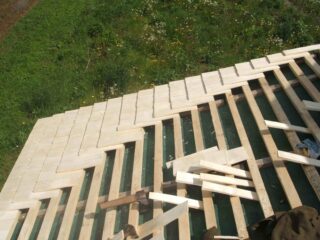
The roof rafter system is made of edged boards. In places of contact with concrete or brick (if any), a two-layer waterproofing is laid. It must be vapor-permeable to prevent wood from rotting due to the accumulation of condensation.
To insulate the roof, waterproofing is first mounted, then mineral wool slabs, and the film is again laid on top. Then the lathing and counter-lathing from ordinary slats are mounted. They are used for installation of tiles directly. Long nails can be used as fasteners.
Installation starts from the bottom of the slopes. When moving up, one should not forget about the partial overlap of the new layer on the old one. If the roof of a residential building is being equipped, the tiled elements are mounted in 3 layers. Two layers are enough to cover utility buildings. A coolant should be installed on the ridge part to help hide the edges of the dies.
At least once a year, the tree should be treated with impregnations that help protect it from bugs, mold fungi, and putrefactive processes. Recommendations for processing and its frequency are given on the packaging of such formulations. On sale you can find impregnations that combine fire-retardant and anti-decay properties. It is not worth covering the tiles with paint and varnish products, since the latter forms cracks over time, into which moisture can penetrate.

